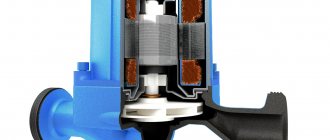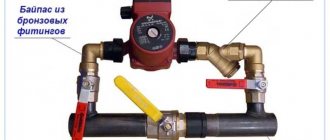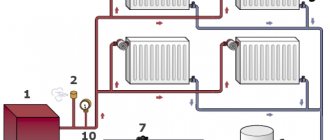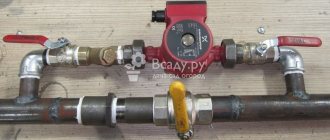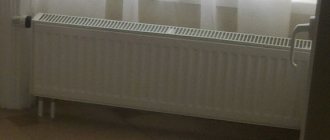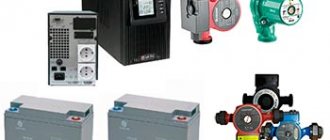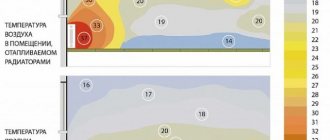Why do you need a circulation pump?
It is no secret that most consumers of heating services living on the upper floors of high-rise buildings are familiar with the problem of cold radiators. Its cause is the lack of necessary pressure. Because if there is no circulation pump, the coolant moves through the pipeline slowly and, as a result, cools down on the lower floors. That is why it is important to correctly calculate the circulation pump for heating systems.
Owners of private households often face a similar situation - in the most remote part of the heating structure, the radiators are much colder than at the starting point.
Experts consider the optimal solution in this case to be the installation of a circulation pump, as it looks like in the photo. The fact is that in small houses, heating systems with natural circulation of coolants are quite effective, but even here it would not hurt to think about purchasing a pump, since if you properly configure the operation of this device, heating costs will be reduced. What is a circulation pump? This is a device consisting of a motor with a rotor immersed in a coolant. The principle of its operation is as follows: by rotating, the rotor forces a liquid heated to a certain temperature to move through the heating system at a given speed, resulting in the creation of the required pressure.
Pumps can operate in different modes. If you set the circulation pump in the heating system to maximum operation, a house that has cooled down in the absence of the owners can be warmed up very quickly. Then consumers, having restored the settings, receive the required amount of heat at minimal cost.
Circulating devices come with a “dry” or “wet” rotor. In the first version, it is partially immersed in the liquid, and in the second - completely. They differ from each other in that pumps equipped with a “wet” rotor make less noise during operation (about
Advantages of devices
Thanks to the special properties of the Wilo pump, the efficiency of the heating system increases significantly. In this case, thin pipes can be used, which, in turn, helps reduce material and fuel costs. Also, when using a pump, the volume of carbon dioxide that is released into the atmosphere is reduced, and the daily consumption of electrical energy is no more than 250 W.
Of course, such a device is not cheap. You will have to pay a large amount for its purchase, but the cost will certainly pay off later when used due to energy savings and durability. The device will not require repair for a long time.
Vilo pumps have many positive properties.
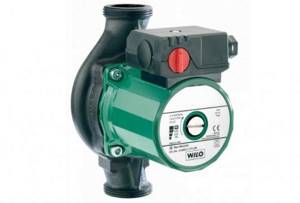
During operation, the working part of the pump is constantly washed by the pumped liquid, so there is no need for regular maintenance of the unit
The most important of them are the following:
- After water evaporates, there is no heat loss.
- The operation of the system can be controlled automatically. The device has a liquid crystal screen, a built-in thermostat and other elements that allow control. You can also manually switch the speed of rotation of the working shaft.
- Compared to many circulation pumps from other brands, Wilo devices are quite compact and therefore do not take up much space.
- The motor and rotor have a multi-stage protection system that helps prevent failure due to sudden surges in voltage in the electrical network.
- The motor operates silently, making it possible to install the device in residential buildings.
Wilo pumps are used in small rooms of several hundred square meters. The selection is carried out according to such parameters as power, volume of circulated water, room area and pressure height. The last parameter is the most important.
You can see how to distinguish an original pump from a fake in the following video:
Procedure for calculating pump parameters
The circulation pump must solve two main problems:
- create in the heating system such a coolant pressure that will be able to overcome the hydraulic resistance that arises in individual structural elements;
- provide the required performance and thereby facilitate the movement of heat through the system, sufficient to heat the house.
Based on the assigned tasks, calculation of the circulation pump for heating is required to determine the thermal energy needs of the house and the hydraulic resistance of the entire system. Without knowing these parameters, it is impossible to select a device for forced movement of coolant.
Calculation of pump performance
The performance of this device is usually denoted in formulas by the letter Q. This value reflects the amount of heat transferred per unit of time.
For calculation use the formula:
Q=0.86R:TF-TR, where
R is the thermal power required to heat the room (kW); TF is the temperature of the coolant in the supply pipe of the system (°C); TR is the temperature in the pipeline at the outlet of the system (°C).
In European countries, the R indicator depends on operating conditions; it is usually calculated in accordance with the standards:
- in houses with no more than two apartments, the power of the circulation pump for heating is taken equal to 100 W/m²;
- in multi-apartment buildings - 70 W/m².
When pump calculations are performed for buildings with poor thermal insulation, the value of the above indicators must be increased. If the building is well insulated, the R value is used, which ranges from 30 to 50 W/m².
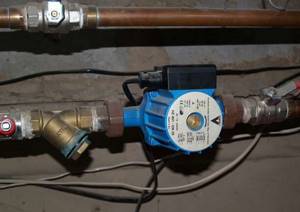
Speroni SpA

In 1946, Giuseppe Speroni from Castelnovo di Sotto opened a small repair shop, Speroni SpA. And soon, assessing the needs of the local consumer, he refocused his business on the production of pumping equipment.
Instead of active development and a quick breakthrough into the global market, a different strategy was chosen, aimed exclusively at the quality of products. Today, like 70 years ago, all of the company’s production facilities (including the laboratory and production and assembly shops) are located in Italy. Which in no way prevents us from promoting pumping equipment (4,000 products are produced per day) on the foreign market (which is about 120 countries). In the Russian Federation, the Italians have deployed a sales and service network and installed a 1-year branded warranty on their products. Some models of Speroni SpA
| Model | Pressure, m / volume, m³/h | Power by operating modes, W | t coolant, C | t environment, C | Installation method / pipe diameter, (inch) | Serviced circuit, m | price, rub. |
| Marina SCR 25/60-180 S/CE | 5.5 / 3.3 | 28-44-63 | -10…+110 | 0…+40 | Thread /1½ | 91 | 4613 |
| Marina SCR 25/40-180 S/CE | 4.5 / 3.3 | 28-44-63 | Thread /1½ | 75 | 4586 | ||
| SPERONI SCR 32-40 | 4 / 3 | 28-44-63 | Thread / 2 | 66 | 2791 |
Watch a video review revealing the production potential and scope of work of Speroni SpA:
Calculation of hydraulic resistance
Another important indicator when choosing a circulation pump is hydraulic resistance, which is what the device will need to overcome.
First of all, you need to find out the suction height H of the pump using the following formula:
H=1.3х(R1L1+R2L2+Z1….+ZN):10000, where
R1, R2 - the value of pressure loss on the supply and return pipes (Pa/m); L1,L2 - length of the supply and return parts of the pipeline (m); Z1,…..ZN – data on the resistance that individual elements of the heating structure have (Pa).
To determine the values of R1 and R2, use tabular data given in special reference books.
When calculating a circulation pump for heating, the hydraulic resistance for the units and elements of the heating supply structure is usually indicated by the manufacturer in the technical documentation attached to the device.
You can use example data:
- heating boiler - 1000-2000 (Pa);
- thermostatic valve - 5000-10000 (Pa);
- mixer - 2000-4000 (Pa);
- heat measuring device -1000-15000 (Pa).
Adjusting circulation pump speeds
Most circulation pump models have a function for adjusting the speed of the device. As a rule, these are three-speed devices that allow you to control the amount of heat that is sent to heat the room. In the event of a sharp cold snap, the operating speed of the device is increased, and when it warms up, it is reduced, despite the fact that the temperature in the rooms remains comfortable for staying in the house.

To change the speed, there is a special lever located on the pump body. Models of circulation devices with an automatic control system for this parameter depending on the temperature outside the building are in great demand.
Other pump calculation options
The above calculation method is one of the options for calculating the necessary parameters. A number of manufacturers use a different technique. You can also entrust the calculation of the circulation pump to a qualified specialist. Knowing the details of the design of a particular system and its operating conditions, he will professionally make all the calculations. Usually the maximum load for the operation of the heating system is determined. In reality, it will be lower, so it would be wise to purchase a device whose parameters are slightly lower than the calculated data. Calculating the power of the heating circulation pump reflects the optimal result. Purchasing a more powerful device is not advisable and the system’s performance will not improve, and costs will increase.
After receiving the calculation results, it is necessary to pay attention to the pressure and flow data on pump models, taking into account its operating speeds. The characteristics can be reflected on a graph with two coordinates - pressure and productivity, and then the point of intersection of these values can be determined. Based on the graphic image, the desired heating pump model is selected for a particular home.
Point A in the figure corresponds to the required parameters based on the calculation results, and point B indicates the actual characteristics of a certain device model specified by the manufacturer. The circulation pump is more suitable for the operating conditions in a particular heating system, the smaller the distance between these two points.
Drain TMW 32/11
This Wilo pump model is a vortex drainer made from various materials. The device is capable of pumping slightly polluted water (meaning those in which the diameter of the pollution particles does not exceed 1 cm).
Brief technical characteristics of the circulation pump Vilo Drain TMW 32/11:
- The maximum depth at which it can be used is 3 m.
- This device has overheat protection. In 60 minutes of operation it will be able to pump 15 cubic meters. meters of water.
- As the name implies, the head height of this device is 11 m, cross-section is 165 mm.
Its average cost is 10,500 rubles.
A few important points
Since circulation pumps are available for sale, equipped with a “dry” or “wet” rotor, with manual or automatic speed control, experts advise purchasing a device whose rotor is completely immersed in the coolant. You should choose it not only because of the reduced noise, but also because it will cope with the load more successfully. The pump should be mounted so that the rotor shaft is in a horizontal position.
To produce a high-quality product, durable steel and a ceramic shaft are used. The service life of such a circulation pump is at least 20 years. You should not choose a device with a cast iron body for hot water supply - it is destroyed very quickly when used in such conditions.
It is preferable to buy a product made of stainless steel, bronze or brass.
When noise is heard in the system when the pump is operating, this does not always indicate a breakdown. Often the cause of its appearance is air that has entered the system after it has been started. Therefore, before starting the heating structure, you need to bleed the air using special valves. When the system has been running for a couple of minutes, this procedure must be repeated and the pump adjusted.
Constructions
There are only two types:
"Wet"
The device is placed in a liquid, which is a cooling lubricant for a running engine.
Among the advantages of “wet” type pumps are:
- Quiet operation.
- Light weight and size.
- Economical energy consumption.
- Long-term work without interruptions.
- Ease of repair.
They have only one drawback - low efficiency. It does not exceed 50%, so such devices are better suited for small domestic buildings.
"Dry"
Its design is different in that the rotor does not come into contact with the liquid.
Compared to the previous type, its efficiency is 80%, but there are the following disadvantages:
- Noise during operation , so it is better to install them in a special enclosed area;
- High requirements for cleanliness of liquid and air to avoid depressurization of sealing rings.
“Dry” are produced in three variations: horizontal, vertical and block. This setting is based on the location of the motor inside the device.


